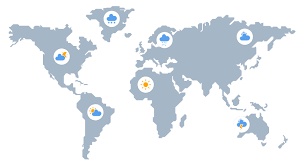Accessing real-time weather information has become essential for numerous applications, ranging from weather forecasting to developing location-based services and creating personalized weather apps. With the advent of Weather APIs (Application Programming Interfaces), developers can easily integrate current weather data API into their applications, websites, and services. In this article, we'll delve into the world of Weather APIs, discussing how to access current weather data effortlessly.
Understanding Weather APIs
Weather APIs allow developers to retrieve up-to-date weather information programmatically. These APIs typically provide data such as temperature, humidity, wind speed, and weather conditions for a specific location. By leveraging Weather APIs, developers can incorporate dynamic weather data into their projects without the need to manually collect and update it.
Choosing the Right Weather API
When selecting a Weather API, developers often consider factors such as data accuracy, reliability, ease of use, and cost. Some popular Weather APIs include:
- Weather Channel API: Offered by The Weather Company, an IBM business, this API provides accurate and reliable weather data worldwide.
- Weatherstack API: Known for its simplicity and comprehensive weather data coverage, Weatherstack offers real-time weather information through a straightforward API.
- OpenWeatherMap: With its extensive weather data coverage and easy-to-use API, OpenWeatherMap is a popular choice among developers for accessing current weather information.
Accessing Current Weather Data
Integrating current weather data into your application is straightforward with Weather APIs. Most Weather APIs offer RESTful endpoints, allowing developers to retrieve weather data using HTTP requests. Here's a simplified example of how to fetch current weather data using JavaScript:
// Example code to fetch current weather data using JavaScript and Weather APIconst apiKey = 'YOUR_API_KEY';const city = 'New York';fetch(`https://api.weatherapi.com/v1/current.json?key=${apiKey}&q=${city}`).then(response => response.json()).then(data => {// Process the weather dataconsole.log(data);}).catch(error => {console.error('Error fetching weather data:', error);});
Replace 'YOUR_API_KEY' with your actual API key obtained from the Weather API provider, and 'New York' with the desired location. This code sends a request to the Weather API endpoint and retrieves the current weather data in JSON format.
The Importance of Weather Data
Weather data is recorded to provide valuable insights into atmospheric conditions, enabling meteorologists, researchers, businesses, and individuals to make informed decisions. From predicting weather patterns to assessing climate change impacts, accurate weather data plays a crucial role in various sectors, including agriculture, transportation, and emergency management.
Conclusion
Weather APIs offer a convenient way to access real-time weather data for integration into applications and services. By leveraging these APIs, developers can create dynamic weather applications, personalized dashboards, and location-based services with ease. When choosing a Weather API, consider factors such as data accuracy, reliability, and ease of integration to ensure the best results for your project. With the right Weather API and proper implementation, you can bring the power of live weather data to your fingertips.
In conclusion, demystifying Weather APIs opens up a world of possibilities for developers and businesses seeking to incorporate current weather data into their projects. Whether you're building a weather app, creating a dashboard, or enhancing location-based services, Weather APIs provide the real-time data you need to stay informed and make smarter decisions.


No comments yet